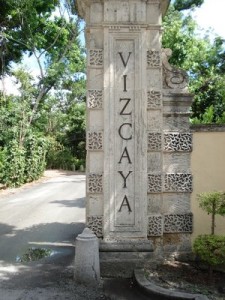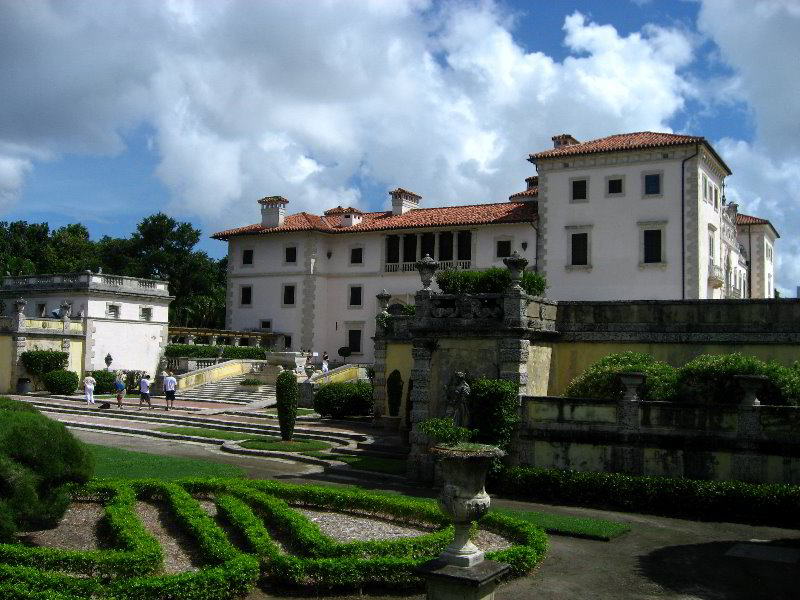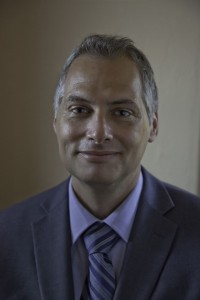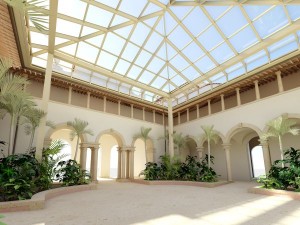 Cultural Corner
Cultural Corner
Vizcaya Museum and Gardens, a Florida Treasure
By Marla E. Schwartz
Miami is the place to go if you want some fun in the sun and frolicking on the beach, but it’s also full of historical places that are worthy of your attention. There are more than a dozen of these notable historical landmarks in Miami, but the one treasure that stands out foremost in the minds of many visitors and residents alike is Vizcaya Museum and Gardens.
Vizcaya Museum and Gardens, located at 3251 South Miami Avenue in

the north Coconut Grove area, is one of the most magnificent museums in the continental United States, as it contains an extremely important collection of artwork and historic artifacts unique among such collections. Additionally, the glorious exterior of the main house was constructed with local coquina limestone, yet has the timelessness of Florence, the gaiety of the Rococo and the glory of Rome, combined in one grand design.
An interesting fact about this estate is as follows: half-brothers Charles and James Deering, sons of wealthy industrialist William Deering, with Charles’ mother being Abbey Reed Barbour and James’ mother being William’s second wife, Clara Hammond Deering, both fell in love with the tropical landscape of Southeast Florida, as many people do, as their father had a winter home in Coconut Grove. After their father’s death they both built their monumental estates in the area: Charles constructed the Deering Estate and James developed Vizcaya.
James, a member of the social elite and an antiquities collector, left a legacy that has enthralled many and will do so for generations. He developed one of the most beautiful places on earth. Consisting of 180 acres on Miami’s Biscayne Bay, the European-inspired estate included the Main House, ten acres of formal gardens, lagoons and islands to the south, and a village that had fruit groves, vegetable and flower gardens and staff residences. Today, this National Historic Landmark preserves 50 acres, 10 acres which includes the European-inspired formal gardens, and 40 acres of native hardwood hammock. The villa’s museum contains 34 rooms of distinctive architectural interiors decorated with numerous antiques, with an art and furnishing collection that spans 2,000 years.
Construction began in 1910 and James wintered there from 1916 until his death in 1925. Vizcaya is distinguished for its Italian Renaissance inspired Mediterranean Revival architecture, its huge Italian Renaissance revival gardens, and lavishly designed, detailed, and executed interior architectural elements with European, Asian, and American furnishings, art and antiquities that span two millennia. The numerous sculptures in the gardens and villa are of ancient Greek, Greco-Roman, and Italian Renaissance origins and styles that reflect James’s desire to showcase art along with the indigenous natural beauty. Vizcaya, unlike other historic house museums, contains the original antiques, furnishings and art thanks to its heirs, who allowed this to happen as long as the estate is used as a public museum in perpetuity.

In 1994 Vizcaya was designated a National Historic Landmark, with an open-air courtyard and extensive gardens on Biscayne Bay and has been undergoing a restoration. Part of this renovation includes installing a glass canopy to replace the protruding glass-and-steel pyramid that covers the courtyard. The canopy will let in more natural light and will be coated to block out heat and ultraviolet radiation.
This $2.7 million project was completed as part of a $50 million renovation of the museum. Joel Hoffman, Executive Director of Vizcaya Museum and Gardens discusses this renovation of the skylight in Vizcaya’s Main House.
Marla E. Schwartz: How will the renovation of the courtyard skylight be different from its previous incarnation?
Joel Hoffman: Vizcaya was built as a winter home and, after it became a public museum, operations extended year-round. Although South Florida is known for its appealing climate, the heat, humidity, sunlight and salt air don’t exactly make for a museum-quality environment. Vizcaya’s Courtyard was first covered in the 1980s to protect the collection from destructive natural elements. At the same time, air conditioning was installed in the house, providing substantially improved conditions for our collections and those who came to see them throughout the year. Conservators recently conducted a comprehensive survey of our interior collections and the good news is that our artworks and furnishings appear to be stable. So our predecessors did a wonderful service for Vizcaya, our community and the art world at large by undertaking that project more than 25 years ago.

We decided it was time to replace the original skylight because it was leaking and not compliant with Miami-Dade County’s stringent hurricane requirements, put in place after Hurricane Andrew. The Federal Emergency Management Agency (FEMA) granted us $1.4 million toward this project, with the balance of funding coming from Miami-Dade County’s Building Better Communities General Obligation Bond. We also were excited about building a new skylight that would be more sympathetic to Vizcaya’s historic architecture.
While we can’t re-open the Courtyard to the exterior, we focused our redesign efforts on making the new skylight as transparent as possible. We’d like to think our visitors will feel like they’re standing outside when they’re in the Courtyard under the new skylight. We know that’s not possible beneath an enclosed structure of metal and glass. But, happily, the new skylight will be much lighter and brighter than the first thanks to technological advances. The 2012 skylight, for example, will have glass panels that are about three or four times larger and much clearer, a substantially simpler structure, and a light, off-white surface that we think will blend with the sky far better than the dark brown metal of the original skylight. These qualities should also provide better views of interesting rooftop elements from within the house.
We’re also using this opportunity to install larger, native trees and other plants in the planters that surround the Courtyard. These are based on research into the original plantings in this space and are intended to re-connect the house with the natural forest that surrounds it.
One of the most complicated aspects of this project was devising a system for protecting our architecture, artwork and visitors during construction. The protection began with the installation of plastic dust barriers around the perimeter of the Courtyard and the enclosure of vulnerable artifacts in bubble wrap and plywood. The contractor, Thornton Construction Company, then filled the Courtyard with scaffolding and suspended a plywood wall around its edge to create another layer of protection. A most important part of this structure is the platform that was built atop the scaffolding to provide a place for workers to dismantle the old skylight, repair the roof, and erect the new skylight piece-by-piece. And, yes, the summer is a challenging time to do this project, given the constant threat of rain and hurricanes. To prevent the Courtyard from filling with water, the platform was built with a waterproof membrane and drainage. The evening after the first panels of glass were removed we experienced not only intense Miami showers but also a hailstorm, and miraculously the Courtyard remained dry. After worrying for some time, I realized that evening that I might actually manage a good night’s sleep while the project was underway!
MES: In terms of the renovation, how did the Vizcaya Museum and Gardens Trust choose master planning consultant LORD Cultural Resources and Richard J. Heisenbottle Architects to advise them on the interpretation and development of Vizcaya, with the goal of advancing Vizcaya as an unparalleled heritage site?
JH: LORD Cultural Resources literally “wrote the textbook” on museum master planning. And Richard J. Heisenbottle is an eminent preservation architect with intimate knowledge of local conditions. Together they did a wonderful job of guiding the process to envision an exciting plan for uniting the east and west sides of the Vizcaya property and creating new learning opportunities for residents of and visitors to South Florida. Key to this process was the preservation and presentation of Vizcaya’s tremendous art, historical and environmental assets.
MES:What can people read about in your blog your blog vizcayamuseum.org/learn-updates.aspthat touches upon the skylight renovation?
JH: My blog provides brief updates on the construction project, with snapshots of the work each week. Thankfully, the most disruptive, noisy work—the demolition of the old skylight and its concrete columns—was completed at the end of June.
MES: How does the preservation and care of Vizcaya’s historic collections and facilities actually provide enhanced educational experiences for Miami-Dade residents and visitors?
JH: Vizcaya is a rare example of a substantially intact estate from the period in American history known as the Gilded Age. Vizcaya provides insight into the early history of Miami—and I continuously muse over the impression James Deering’s seemingly “ancient” home must have made on those residing in or visiting the rather new city of Miami in the 1910s. And, now, people are shocked to learn that, while Vizcaya looks really old, it was filled with such modern conveniences as a central vacuum cleaning system and a player organ that captured the sounds of accomplished musicians about as accurately as an MP3 track today. Vizcaya is also unusual because of the care and creativity that went into its design—and the interiors reflect scholarship and audacity not seen in many other homes of the time. Americans like to think of themselves as mavericks and Vizcaya’s designer exemplified that in his comfort with combining objects and ideas from different periods and places to create a unique and highly personal ensemble. But one cannot miss the extent to which Vizcaya also combines European design with Miami’s plants and building materials, and the results are surprising and innovative. With Vizcaya now restored, the potential for enjoying its aesthetic attributes becomes greater and greater. The visual and intellectual contrast, for example, between our formal gardens and our untamed mangroves was diminished when both were compromised remnants of their original glory. When we are able to restore the remainder of the Vizcaya Village buildings and open these to the public, our capacity to tell the “upstairs/downstairs” aspects of life at Vizcaya, and in early twentieth-century America, will be dramatically enhanced.
MES: When will the Moonlight Garden Tours resume? What about Tea on the Terrace?
JH: Moonlight Garden Tours are held in the winter months so visitors can enjoy our gardens in cooler weather. These will resume in the coming winter, providing visitors a chance to see the new skylight as they grab refreshment or enjoy music in the Courtyard. Tea on the Terrace resumes in October.
MES: As an intellectual, with both a doctorate and master’s degrees in art history from Yale University and an undergraduate degree in English literature from University of Pennsylvania, you obviously have a unique perspective as how to breathe new life into Vizcaya. Therefore, can you tell me a little bit about how you first became interested in Vizcaya and what does it mean to you on a personal level?
JH: I first experienced Vizcaya when I relocated to Miami from New York in 1994, and I was thoroughly impressed by its cultural significance and its inspired combination of natural and designed beauty. After working at The Wolfsonian-FIU for several years, I left Miami to oversee educational programming at the Brooklyn Museum, because I was fascinated by that organization’s commitment to engaging the local community in the life of the museum. When the directorship of Vizcaya was advertised, I saw an unprecedented opportunity to participate in the transformation of this museum, which was recognized around the world for its cultural significance but somewhat taken for granted in Miami and appreciated most as a venue for events. To be honest, I live, sleep and breathe Vizcaya, so I’m passionate about the value of bringing back its luster, unlocking its interesting history, and helping people realize how important the estate is to our community. Every day is a stimulating challenge, whether dealing with leaky pipes, errant alligators or an interpretation project. While I feel immensely proud of the accomplishments made by my colleagues, by dedicated volunteers and donors, and by our “parent entity,” Miami-Dade County, we have a long way to go to fulfill our dreams.
Vizcaya is open daily from 9:30 a.m. to 4:30 p.m. except Tuesdays, Thanksgiving and Christmas Day. For more information and exact driving directions go to: vizcaya.org.
 A Toledo, OH native, a graduate of Kent State, Marla E. Schwartz is a Senior Writer for Miami Living Magazine, afreelance writer for Lighthouse Point Magazine and the a cultural arts columnist for AroundWellington.com. Her photographs have appeared in these publications, in many Ohio periodicals, as well as in The Miami Herald, The Ft. Lauderdale Sun-Sentinel and The Palm Beach Post. She has had numerous plays published and produced around the country. Her short play, America’s Working? was produced in Los Angeles at both the First Stage and the Lone Star Ensemble theater companies, in Florida at Lynn University and at an Off-Broadway playhouse in NYC. Her piece, The Lunch Time Café, was a finalist for the Heideman Award, Actors Theatre of Louisville. Please check out the re-prints of her interviews with authors Dave Barry & Ridley Pearson and Dexter novelist Jeff Lindsay in the October 2010 issue #2 and Chris Bohjalian in the April 2011 issue #3 of Duff Brenna’s ServingHouse: A Journal of Literary Arts at www.servinghousejournal.com. You can contact her at marlaschwartz@att.net.
A Toledo, OH native, a graduate of Kent State, Marla E. Schwartz is a Senior Writer for Miami Living Magazine, afreelance writer for Lighthouse Point Magazine and the a cultural arts columnist for AroundWellington.com. Her photographs have appeared in these publications, in many Ohio periodicals, as well as in The Miami Herald, The Ft. Lauderdale Sun-Sentinel and The Palm Beach Post. She has had numerous plays published and produced around the country. Her short play, America’s Working? was produced in Los Angeles at both the First Stage and the Lone Star Ensemble theater companies, in Florida at Lynn University and at an Off-Broadway playhouse in NYC. Her piece, The Lunch Time Café, was a finalist for the Heideman Award, Actors Theatre of Louisville. Please check out the re-prints of her interviews with authors Dave Barry & Ridley Pearson and Dexter novelist Jeff Lindsay in the October 2010 issue #2 and Chris Bohjalian in the April 2011 issue #3 of Duff Brenna’s ServingHouse: A Journal of Literary Arts at www.servinghousejournal.com. You can contact her at marlaschwartz@att.net.

